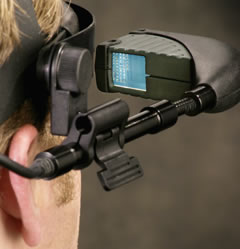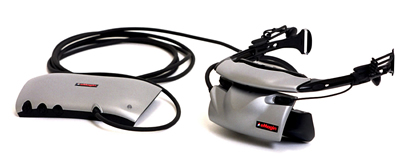Among the applications already utilizing OLED include the full-color ProView SO-35 monocular viewer from Kaiser Electro-Optics, providing thermal sighting and situational awareness. Proview SO-35 developed for the US Army Land Warrior Program. Another helmet mounted display was introduced in 2004 by Liteye. The LE-450 monocular rugged pod-mounted viewer fits comfortably on the helmet’s NVG attachment, providing day/night viewing capability. The ruggedized system conforms to Milspec 810E / 640, can be submerges in water up to 10 meters deep, It can be used in cold temperatures of up to -40C to +85 degrees, LE-500 head-mounted viewer provides similar performance with “see-through” capability.
A different device is the Expedition system from Quantum3D’s, integrating eMagin’s Z800 3D Visor with a THERMITE wearable computer into an embedded-training platform. This Tactical Visual Computer can be coupled with a weapon-mounted synthetic environment controller, correlated head/body/weapon motion trackers, and load-bearing vest, to provide an integrated, wireless, open-architecture platform enabling rapid development and deployment of embedded training and mission-rehearsal scenarios. eMagin’s Z800 3DVisor provides full-color, 360-degree 3D stereovision, hi-fi stereo sound and a noise-canceling microphone to support group training scenarios as well as individual-based training sessions.
A different application for the Z800 is the a new anxiety therapy system called “Virtual Iraq”. Under development by Virtually Better, with Naval Research Office funding, the Virtual Reality (VR) system supports exposure therapy of anxiety disorders resulting from the high-stress environment. The treatment involves exposing the patient to a virtual environment containing the feared situation rather than taking the patient into the actual environment or having the patient imagine the stimulus. The 3DVisor is used to delivering an immersive VR exposure required for a successful treatments.
eMagin’s microdisplay is also used in the Hand-Held Thermal Imager (HHTI) from DRS Technologies’ Surveillance and Reconnaissance Group. OLED displays are integrated into Simrad Optronics’ LP10TL Target Locator, used by forward observers. The system has a dual 7x or12x magnification and target locator system, incorporating GPS and digital magnetic compass. LP10TL operates effectively in temperatures as low as -30oC, demonstrating the OLED’s endurance to low temperature conditions. At the other temperature extreme, OLED is embedded in the Fire-Warrior micro thermal imaging system, produced by Total Fire. This monochrome, helmet-based unit provides hands-free thermal imaging for firefighters, leaving both hands free for the work of fighting while providing critical visual information.
Two additional applications have integrated OLED into a weapon’s sights designed for modern warrior programs – SaabTech is using the displays in head-mounted devices for applications that require visualization of full-color, high-resolution information, such as evaluation of reconnaissance photos, communication of critical command and control information, computer-aided design, urban planning, medical training, and similar applications. ITL’s subsidiary NA-OR is fitting eMagin’s OLEDs into their Advanced Integrated Soldier System (AISS). All visual interfaces to the user in the AISS system feature eMagin’s OLED displays. According to Giora Kutz, Managing Director of NA-OR subsidiary, AISS is designed to provide the soldier with instant access to the information he needs. “eMagin’s OLED displays are immediately responsive, bright and easy on the eye during extended use, they’ve proven rugged enough to withstand harsh environments.” Says Kutz. The system has already been presented to potential customers and is currently being evaluated by the IDF.
Another application using OLED will be the next generation AN/AVS-7 (ANVIS-HUD) Head Unit Display developed by Elbit Systems. Mounted on a night vision goggle, the AN/AVS-7 system enables display of mission-critical information to the pilot while flying heads up. This advanced electro-optical system combines images seen through the night vision headset with computer-generated graphic and digital symbology. Announced in mid 2004, this was the first avionic application of OLED microdisplays.
Additional parts of this article:
- Military application of OLED micro-display technology
- Applications Using OLED Microdisplays
- Wearable, Wrappable Displays
- How OLED Works?

















